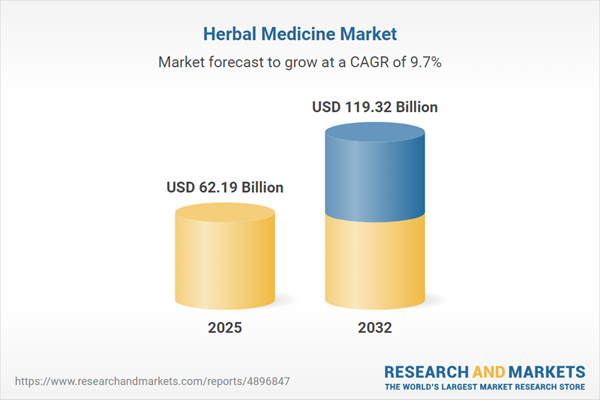Speak directly to the analyst to clarify any post sales queries you may have.
The herbal medicine market is undergoing dynamic change as regulations tighten, technology accelerates, and operational complexities rise. For senior executives, strategic adaptation is essential to seize new opportunities, minimize compliance risk, and build competitive advantage in this evolving sector.
Market Snapshot: Herbal Medicine Market Size and Growth
In 2024, the global herbal medicine market reached USD 56.94 billion and is forecast to rise to USD 62.19 billion by 2025, reflecting a compound annual growth rate of 9.68% through 2032. This growth is driven by a surge in demand for natural wellness solutions, increasing adoption across clinical and consumer channels, and rapid integration of digital infrastructure within healthcare supply and distribution. Companies are prioritizing digital supply chain upgrades to improve compliance, streamline risk management, and reinforce resilience in response to stricter regulations. As the herbal medicine market accelerates, organizations face a landscape of both expanded opportunity and heightened operational complexity.
Scope & Segmentation of the Herbal Medicine Market
- Form: Creams, ointments, essential oils, liquid extracts, powders, syrups, tablets, capsules, teas, and infusions enable alignment with varied consumer and clinical needs, expanding access across health-focused demographics.
- Botanical Origin: Sourcing from barks, flowers, fruits, seeds, leaves, and roots supports consistent supply chains and fortifies brand credibility. Strong provenance management and quality control practices are increasingly emphasized.
- Type: Products extend into beauty, cosmetics, dietary supplements, functional foods, and pharmaceuticals, offering organizations entry into high-potential adjacent markets and allowing broader penetration into holistic health sectors.
- Indication: Market solutions address cardiovascular, respiratory, digestive, immune system, skin, reproductive, organ, and mental health concerns, keeping organizations aligned with changing health priorities and therapeutic advancements.
- Distribution Channel: Ayurvedic clinics, traditional practitioners, direct sales, wellness retailers, pharmacies, online platforms, supermarkets, and hypermarkets provide multi-channel accessibility for both B2B and retail segments.
- Regions Covered: The market strategy spans the Americas, Europe, Asia-Pacific, and Middle East & Africa, with targeted presence in key locations such as the United States, Canada, Germany, China, India, Japan, Brazil, and South Africa, enhancing localized product delivery and regulatory compliance strategies.
- Key Companies Assessed: Analysis includes Ayush Herbs, Baidyanath Ayurved, Bionorica SE, Blackmores Limited, Cultivator Natural Products Pvt. Ltd., DABUR Limited, Emami Limited, Gaia Herbs, Herbal Hills, and Himalaya Global Holdings Ltd., informing strategic partnerships and benchmarking efforts.
Key Takeaways: Strategic Insights for Herbal Medicine Stakeholders
- Advanced digital infrastructure adoption streamlines enterprise data flows and enhances responsiveness to market changes.
- Dedicated regulatory and compliance teams allow proactive risk management and sustain critical business partnerships.
- Leveraging real-time analytics from supply chains and consumer insights improves strategic decision speed and market agility.
- Sustainable sourcing and environmentally conscious packaging address increasing procurement demands and regulatory audits around ecological impact.
- Localization of marketing and compliance frameworks strengthens alignment with region-specific consumer and regulatory requirements.
- Collaboration with research entities cultivates innovation and scientific validation, supporting regulatory adaptation and trust in herbal medicine outcomes.
Tariff Impact: Adapting Herbal Medicine Supply Chains Amid US Tariffs
The imposition of recent US tariffs on herbal medicine imports requires organizations to emphasize domestic sourcing and diversify supply networks. This adaptation in procurement and logistics is vital to limit regulatory exposure and safeguard business continuity amid ongoing trade uncertainties.
Research Methodology & Data Sources
This report draws on in-depth interviews with senior industry leaders and regulatory experts, supplemented by reviews of scientific literature, regulatory frameworks, and global trade data. Findings are subjected to peer review, ensuring rigor and executive relevance.
Why This Report Matters
- Senior leaders receive targeted insights on regulatory changes, digital transformation, and sustainable sourcing within the herbal medicine market.
- Segment-specific analysis and competitor benchmarking support confident, proactive business planning and risk assessments.
- Actionable recommendations guide teams in aligning development, compliance, and regional expansion strategies for comprehensive market success.
Conclusion
Continuous innovation, robust quality assurance, and adaptive compliance systems are central to sustaining organizational relevance and resilience in the herbal medicine sector.
Additional Product Information:
- Purchase of this report includes 1 year online access with quarterly updates.
- This report can be updated on request. Please contact our Customer Experience team using the Ask a Question widget on our website.
Table of Contents
3. Executive Summary
4. Market Overview
7. Cumulative Impact of Artificial Intelligence 2025
Companies Mentioned
The companies profiled in this Herbal Medicine market report include:- Ayush Herbs herbal products Company
- Baidyanath Ayurved
- Bionorica SE
- Blackmores Limited
- Cultivator Natural Products Pvt. Ltd.
- DABUR Limited
- Emami Limited
- Gaia Herbs, Inc.
- Herbal Hills
- Himalaya Global Holdings Ltd.
Table Information
| Report Attribute | Details |
|---|---|
| No. of Pages | 193 |
| Published | November 2025 |
| Forecast Period | 2025 - 2032 |
| Estimated Market Value ( USD | $ 62.19 Billion |
| Forecasted Market Value ( USD | $ 119.32 Billion |
| Compound Annual Growth Rate | 9.6% |
| Regions Covered | Global |
| No. of Companies Mentioned | 11 |









